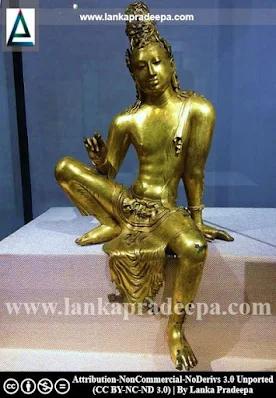
|
Veheragala Avalokitesvara Bodhisattva Statue |
Veheragala Avalokitesvara Bodhisattva Statue (Sinhala: වෙහෙරගල අවලෝකිතේශ්වර බෝධිසත්ත්ව ප්රථිමාව) is currently on display in the Colombo National Museum, Sri Lanka (Prematilaka & Hewage, 2018). It is considered one of the masterpiece sculptures of the world (Chandrajeewa, 2016; Prematilaka & Hewage, 2018).
Discovery
The statue was discovered in 1968 along with a group of Buddhist images (Standing Buddha Statue, Seated Buddha Statue etc.) among the ruins of an ancient building in the precincts of Siri Sangabodhi Viharaya in Veheragala in Anuradhapura District by the then chief incumbent of the temple, Mahamessalave Rathanapala Thera (Chandrajeewa, 2016; Chutiwongs et al., 2007). It was later brought to the present location for conservation.
This statue along with some other 51 bronzes was taken away from the Colombo Museum in 1991 and was on display till 1993 in several museums around the world including France, Switzerland, the United States, and Australia (Chandrajeewa, 2016).
Avalokiteshvara

This solid-cast gilt bronze represents Avalokiteshvara, a Mahayana Bodhisattva who is the emanation of the Dhyani Buddha Amitabha. These figures (Avalokiteshvara) are identified by the Dhyani Buddha on the headdress or by similar images with the emblem. The statue has been variously dated by scholars between the 6th and the 10th century A.D. (Chandrajeewa, 2016). Senarath Paranavitana has dated this to the 6th century while others have dated it to the 8th-10th century (Chandrajeewa, 2016; Chutiwongs et al., 2007; Holt, 1991). The style shows affinities to South Indian sculptures of the 7th-9th centuries (Chutiwongs et al., 2007).
The Statue
The statue is 49.8 cm in height and is made from bronze using the lost wax process (Chandrajeewa, 2016; Chutiwongs et al., 2007). It is in a combination of the attitudes of Rajaleelasana (royal easy posture) and Lalithasana (Chandrajeewa, 2016; Chutiwongs et al., 2007). The right foot of the statue is bent and kept crosswise over the seat while the left foot is kept down. The right hand is resting over the right thigh and depicts the Vitarka Mudra (Mudra of argumentation) or Katakahasta (Chutiwongs et al., 2007; Wikramagamage, 1990). The left hand is kept on the throne (now missing) outside the left thigh causing the upper body to slant towards the right.
The cloth band on the left shoulder and the ripples on the belly are shown in their natural form. The raiment covering the lower body is short and a portion of this cloth is falling in the front below the seat (Wikramagamage, 1990). The hair is arranged in the form of Jata-makuta (Wikramagamage, 2004) and several loose locks are fallen onto the shoulders. The hairdress is garnished with stones but bears an empty niche in the front (Chandrajeewa, 2016). This empty niche, according to scholars, had been used to place a miniature figure of Amitabha, the celestial Buddha of the present age and the spiritual progenitor of Avalokitesvara (Chandrajeewa, 2016; Chutiwongs et al., 2007; Wikramagamage, 1990)
Johanna van Lohuizen-de Leeuw (1919-1983) identified this statue as the most superb representation of such a noble saviour of mankind ever created anywhere in the world (Chutiwongs et al., 2007).
Related Posts
Read Also
References
Books, Journal Articles
1) Chandrajeewa, S., 2016. Veragala Avalokiteśvara Bodhisattva: an Inquiry into its Style & Period (The Mahayana Buddhist Bronze Statue in Colombo Museum). Journal of the Royal Asiatic Society of Sri Lanka, pp.69-106.
2) Chutiwongs, N.; Prematilleke, L.; Silva, R., 2007. Sri Lanka Murthi: Bodhisattva (Sri Lanka Sculpture: Bodhisattva). Central Cultural Fund. Ministry of Cultural Affairs. pp.74-75.
3) Holt, J.C., 1991. Buddha in the crown: Avalokitesvara in the Buddhist traditions of Sri Lanka. Oxford University Press. p.86.
4) Prematilaka, L., Hewage, R., 2018. A guide to the National Museum,
Colombo: Department of National Museum. ISBN: 978-955-578-035-3. p.12.
5) Wikramagamage, C., 1990. [Wijesekara, N. (Editor in chief)] Section II: 500-100 A.D. Archaeological Department Centenary (1890-1990): Commemorative Series: Vol. IV: Sculpture. p.68
6) Wikramagamage, C., 2004. Heritage of Rajarata: Major natural, cultural and historic sites: Colombo. Central Bank of Sri Lanka. p.85.

